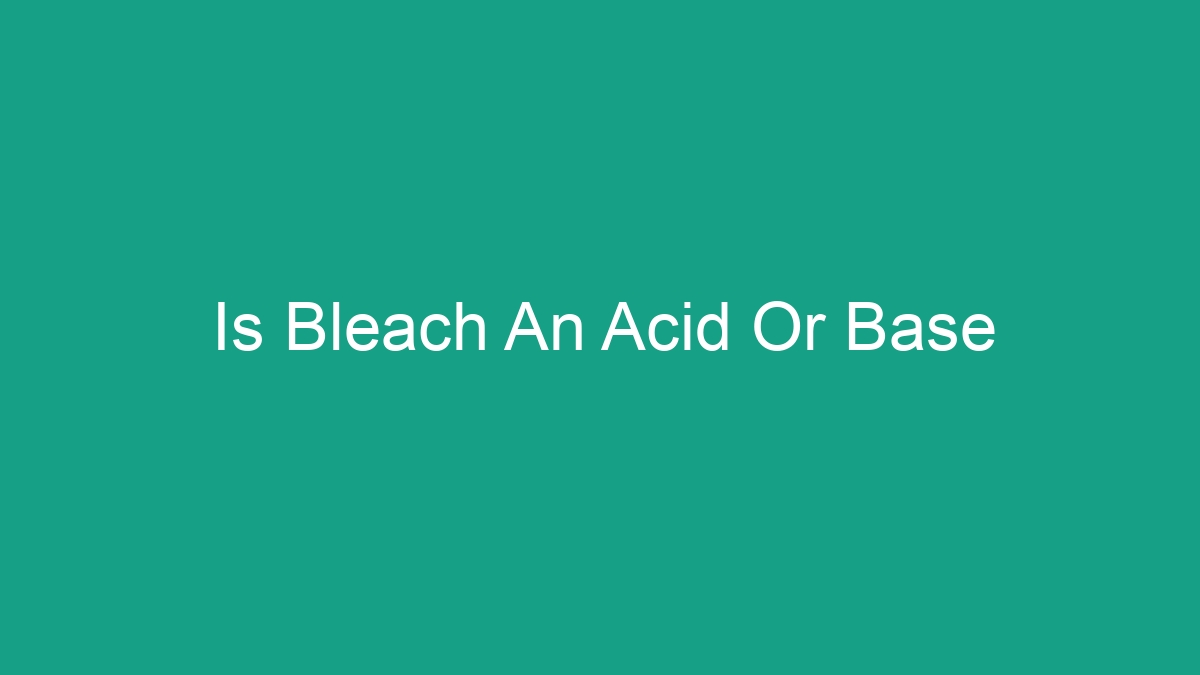
When it comes to cleaning and disinfecting, bleach is a commonly used household product. However, there is some confusion about whether bleach is an acid or a base. In this article, we will explore the chemical makeup of bleach and determine whether it is classified as an acid or a base.
Understanding Acids and Bases
Before diving into the specifics of bleach, it’s important to have a basic understanding of acids and bases. Acids and bases are two categories of chemical compounds that are defined by their properties and behavior in chemical reactions.
Acids are compounds that donate hydrogen ions (H⁺) when dissolved in water. They have a sour taste, can turn blue litmus paper red, and have a pH of less than 7. Some common examples of acids include vinegar (acetic acid), lemon juice (citric acid), and hydrochloric acid.
Bases, on the other hand, are compounds that accept hydrogen ions or donate hydroxide ions (OH⁻) when dissolved in water. They have a bitter taste, feel slippery to the touch, and turn red litmus paper blue. Bases typically have a pH of more than 7. Common examples of bases include baking soda (sodium bicarbonate), ammonia, and lye (sodium hydroxide).
The Chemical Makeup of Bleach
Bleach is a common household chemical that is used for disinfecting, whitening, and removing stains. The active ingredient in most household bleach products is sodium hypochlorite (NaClO).
Sodium hypochlorite is a compound that is formed when chlorine is dissolved in sodium hydroxide. It is a strong oxidizing agent and has the ability to release oxygen and disinfect surfaces. The chemical formula for sodium hypochlorite is NaClO, and it is composed of sodium, chlorine, and oxygen atoms.
Is Bleach An Acid or Base?
Based on the properties and behavior of bleach, it is classified as a base. This classification is due to the presence of sodium hypochlorite, which is a compound that releases hydroxide ions (OH⁻) when dissolved in water.
When bleach is mixed with water, the sodium hypochlorite dissociates into sodium ions (Na⁺) and hypochlorite ions (ClO⁻). The hypochlorite ions are what gives bleach its disinfecting and bleaching properties. The release of hydroxide ions when bleach is dissolved in water is a characteristic of bases, further supporting the classification of bleach as a base.
pH Level of Bleach
The pH scale is a measure of the acidity or basicity of a solution, ranging from 0 to 14. A pH of 7 is considered neutral, while pH values less than 7 are acidic and pH values greater than 7 are basic. The pH level of bleach typically falls in the basic range, around 11-13.
The high pH level of bleach is what gives it its strong cleaning and disinfecting properties. It can effectively kill bacteria, viruses, and mold, making it a powerful tool for sanitizing surfaces and removing tough stains.
Common Uses of Bleach
Bleach has a wide range of uses in both household and industrial settings. Some common uses of bleach include:
- Disinfecting: Bleach is often used to disinfect surfaces in kitchens and bathrooms, as well as in hospitals and healthcare facilities.
- Whitening: It is commonly used to whiten and brighten laundry, especially for white clothing and linens.
- Stain Removal: Bleach can effectively remove tough stains from fabrics and surfaces, such as coffee or tea stains.
- Mold Removal: Its powerful disinfecting properties make it an effective tool for removing and preventing mold growth.
Precautions When Using Bleach
While bleach is a versatile and effective cleaning agent, it is important to use it with caution. Some precautions to keep in mind when using bleach include:
- Ventilation: Always use bleach in a well-ventilated area to avoid inhaling fumes.
- Protective Gear: Wear gloves and eye protection when handling bleach to prevent skin and eye irritation.
- Never Mix with Ammonia: Mixing bleach with ammonia or other acids can produce toxic fumes that are harmful when inhaled.
- Proper Dilution: Follow instructions for diluting bleach to the appropriate concentration for specific cleaning tasks.
FAQs About Bleach
Q: Can bleach be used to disinfect surfaces?
A: Yes, bleach is a powerful disinfectant that can effectively kill bacteria, viruses, and mold on surfaces.
Q: Is it safe to mix bleach with other cleaning products?
A: No, mixing bleach with ammonia or other acids can produce toxic fumes. It is important to use bleach on its own and avoid mixing it with other chemicals.
Q: What are the different types of bleach?
A: There are two main types of household bleach: chlorine bleach (sodium hypochlorite) and oxygen bleach (hydrogen peroxide). Chlorine bleach is the more common type and is a strong disinfectant, while oxygen bleach is gentler and safe for colored fabrics.
Q: Can bleach be used to remove mold from surfaces?
A: Yes, bleach is an effective tool for removing and preventing mold growth on surfaces. However, it is important to follow proper precautions and dilution instructions when using bleach for mold removal.
Q: Is bleach safe for use on all types of fabrics?
A: Chlorine bleach can cause damage to some fabrics, especially colored or delicate fabrics. It is important to check garment labels and use oxygen bleach for colored fabrics.



